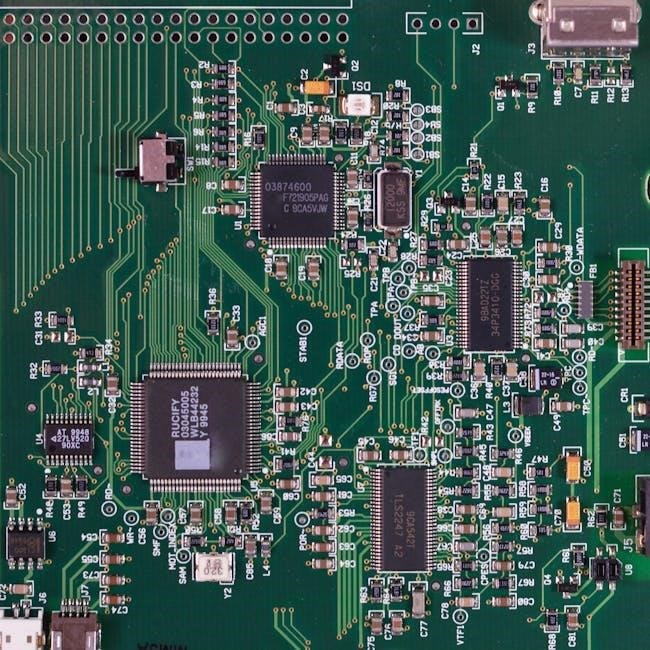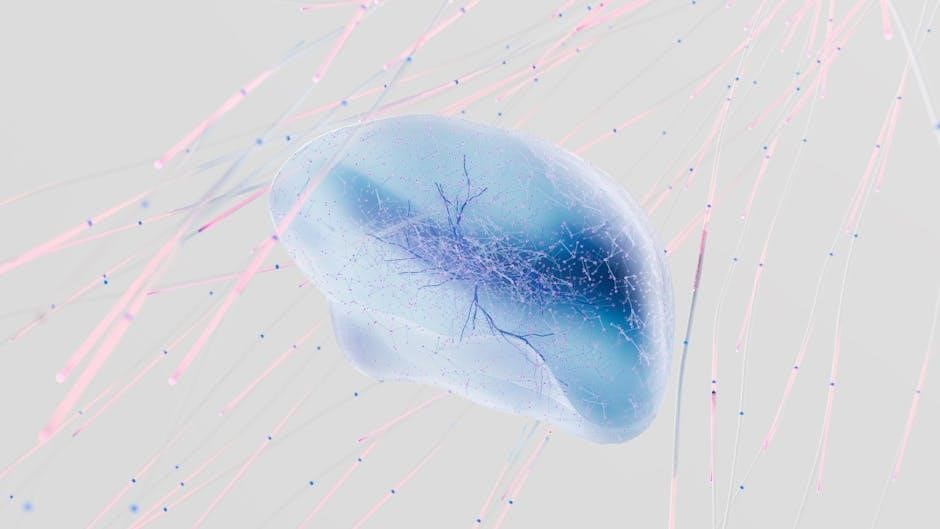The musculoskeletal system is the body’s support structure, comprising bones, muscles, and joints that provide stability, protection, and enable movement. It is a dynamic system essential for movement, stability, and protecting internal organs, while also playing a role in maintaining body temperature and overall physical function.
1.1 Definition and Overview
The musculoskeletal system is a complex network of bones, muscles, joints, tendons, and ligaments that provides structural support, enables movement, and protects internal organs. It is a dynamic system essential for maintaining posture, facilitating motion, and absorbing shocks. This system is vital for overall physical function, combining the skeletal framework with muscular activity to ensure mobility and stability. Its integrated components work synergistically to support the body’s daily activities and maintain its structural integrity. Proper functioning of this system is crucial for health and well-being.
1.2 Importance of the Musculoskeletal System
The musculoskeletal system is essential for maintaining posture, enabling movement, and protecting vital organs. It provides structural support, absorbs shocks, and facilitates physical activity. This system also plays a role in blood cell production and maintaining body temperature. Its proper functioning is crucial for overall health, mobility, and quality of life. Dysfunction or injury to this system can lead to significant disability, emphasizing the importance of maintaining its health through proper care and management.

Components of the Musculoskeletal System
The musculoskeletal system consists of bones, muscles, joints, tendons, and ligaments, working together to enable movement, provide stability, and protect the body while supporting its structural and functional needs.
2.1 Skeletal System
The skeletal system is a framework of bones that provides structural support and protection for the body. It is divided into the axial skeleton (skull, spine, ribs) and the appendicular skeleton (limbs and pelvis). Bones are made of specialized connective tissue, offering rigidity and strength. They work with muscles and joints to facilitate movement, protect internal organs, and produce blood cells in the bone marrow. This system is essential for maintaining posture and enabling mobility.
2.2 Muscular System
The muscular system consists of specialized tissues that enable movement, maintain posture, and regulate body functions. It includes skeletal muscles (attached to bones), smooth muscles (found in internal organs), and cardiac muscle (exclusive to the heart). Skeletal muscles work with the skeletal system to facilitate voluntary movements, while smooth and cardiac muscles handle involuntary functions like digestion and blood circulation. This system is crucial for mobility, stability, and maintaining overall bodily functions.
2.3 Connective Tissues
Connective tissues are essential components of the musculoskeletal system, providing structural support and enabling movement. They include tendons (connecting muscles to bones), ligaments (linking bones to joints), and fascia (surrounding muscles and organs). These tissues enhance flexibility, absorb shock, and maintain posture. Additionally, bursae (fluid-filled sacs) reduce friction between moving parts, protecting organs and ensuring smooth joint function. Connective tissues are vital for maintaining the integrity and functionality of the musculoskeletal system, enabling efficient movement and stability.

Functions of the Musculoskeletal System
The musculoskeletal system provides support, enables movement, protects internal organs, and aids in blood cell production. It is essential for maintaining posture, facilitating mobility, and safeguarding vital body structures.
3.1 Support and Stability
The musculoskeletal system provides structural support, maintaining the body’s posture and balance. Bones act as the framework, while muscles and connective tissues stabilize joints. This system protects vital organs, such as the brain and heart, by absorbing shocks and distributing forces. Proper alignment and strength ensure stability, enabling daily activities without strain. The interplay between bones, muscles, and ligaments creates a robust framework, essential for both static and dynamic stability, ensuring the body functions efficiently and safely. This foundation is critical for overall physical health and mobility;
3.2 Movement and Mobility
The musculoskeletal system enables movement and mobility by coordinating the actions of bones, muscles, and joints; Muscles contract to pull bones, creating motion at joints. This system allows for a wide range of movements, from walking and running to fine motor tasks. Ligaments and tendons provide stability, ensuring precise and controlled motion. The system’s flexibility and strength enable individuals to perform daily activities, adapt to physical demands, and maintain functional independence, making it essential for overall mobility and quality of life.
3;3 Protection of Internal Organs
The musculoskeletal system plays a vital role in protecting internal organs. Bones such as the ribcage safeguard the heart and lungs, while the skull protects the brain. The vertebral column shields the spinal cord, preventing damage. Muscles and connective tissues provide additional padding and support, absorbing shocks and reducing impact on sensitive organs. This protective function is essential for maintaining the integrity of vital organs and ensuring overall bodily function and survival.
3.4 Blood Cell Production
The musculoskeletal system, particularly the skeletal system, plays a crucial role in blood cell production. Bones contain bone marrow, the spongy tissue responsible for producing red and white blood cells, as well as platelets. Red blood cells transport oxygen, white blood cells fight infections, and platelets aid in blood clotting. This process is essential for maintaining immune function, oxygen delivery, and preventing bleeding. The musculoskeletal system’s role in hematopoiesis highlights its importance in overall health and bodily functions.
The Skeletal System
The skeletal system consists of bones and cartilage, providing structural support, protection for vital organs, and attachment points for muscles to facilitate movement and maintain posture.

4.1 Structure of Bones
Bones are specialized connective tissues that form the framework of the body. They consist of a shaft (diaphysis) and ends (epiphyses), covered by a protective membrane called the periosteum. Compact bone forms the dense outer layer, while spongy bone inside provides shock absorption. The bone matrix, made of collagen and minerals like calcium, gives bones strength and rigidity. Bones also contain marrow, which produces blood cells, and are connected by joints, enabling movement and support for the musculoskeletal system.

4;2 Axial and Appendicular Skeleton
The skeletal system is divided into the axial and appendicular skeletons. The axial skeleton includes the skull, spine, ribs, and sternum, forming the body’s central axis and protecting vital organs like the brain and heart. The appendicular skeleton comprises the upper and lower limbs, shoulders, and pelvic girdles, enabling movement and locomotion. Together, they provide structural support and facilitate the body’s ability to move and maintain posture while protecting internal organs effectively.
4.3 Joints and Their Classification
Joints, or articulations, are points where bones meet, enabling movement and stability. They are classified based on movement: synarthroses (immovable), amphiarthroses (slightly movable), and diarthroses (freely movable). Examples include sutures in the skull (synarthroses), vertebrae (amphiarthroses), and knee joints (diarthroses). This classification highlights the musculoskeletal system’s adaptability, allowing for a wide range of motion while maintaining structural integrity and supporting various bodily functions effectively.
4.4 Ligaments and Tendons
Ligaments and tendons are crucial connective tissues in the musculoskeletal system. Ligaments connect bones to bones, providing stability and limiting excessive movement at joints. Tendons attach muscles to bones, enabling efficient transmission of forces for movement. Both structures are composed of collagen fibers, offering strength and elasticity. They play a vital role in maintaining joint integrity and facilitating precise bodily movements, while also protecting against injury by absorbing stress and distributing pressure effectively.

The Muscular System
The muscular system consists of specialized tissues that enable movement, provide support, and regulate body temperature. It works in harmony with the skeletal system to facilitate motion and maintain posture, comprising three types of muscles: skeletal, smooth, and cardiac, each serving distinct functions within the body.
5.1 Types of Muscles
The muscular system comprises three primary types of muscles: skeletal, smooth, and cardiac. Skeletal muscles are voluntary, attached to bones, and enable movement. Smooth muscles are involuntary, found in internal organs, and facilitate functions like digestion. Cardiac muscle is specialized for the heart, ensuring rhythmic contractions. Each type has distinct structures and roles, working together to maintain movement, support, and overall bodily functions efficiently.
5.2 Muscle Function and Movement
Muscles function by contracting and relaxing to enable movement, maintain posture, and regulate body temperature. Skeletal muscles work with bones and joints to produce voluntary movements, while smooth muscles handle involuntary actions like digestion. The coordinated effort between muscles, bones, and connective tissues allows for precise and efficient motion. This system is essential for daily activities, from walking to fine motor skills, ensuring the body operates smoothly and maintains overall mobility and stability. Proper muscle function is vital for a healthy, active lifestyle.
5.3 Muscle Fibers and Contraction
Muscle fibers are the building blocks of muscles, responsible for contraction and relaxation. Skeletal muscle fibers are long, multinucleated cells that enable voluntary movements. Smooth muscle fibers are shorter and spiral-shaped, facilitating involuntary actions like digestion. Cardiac muscle fibers are specialized for the heart’s rhythmic contractions. Contraction occurs through the sliding filament theory, where actin and myosin filaments slide past each other, shortening the muscle. This process is essential for movement, maintaining posture, and regulating body functions, making muscle fibers vital for overall musculoskeletal function and daily activities.
5.4 Role in Posture and Balance
Muscles play a crucial role in maintaining posture and balance by working in coordination with the skeletal system. Core muscles, including the abdominals and back muscles, provide stabilization, preventing excessive movement and maintaining alignment. Postural muscles like the erector spinae and trapezius help uphold the body’s position against gravity. Balance is achieved through subtle muscle contractions and relaxations, guided by the nervous system. This intricate system ensures stability during both static postures and dynamic movements, essential for daily activities and preventing injuries.
Connective Tissues in the Musculoskeletal System
Connective tissues, such as tendons, ligaments, fascia, and bursae, connect and support musculoskeletal components, enabling movement and reducing friction between structures while maintaining system integrity and function.
6.1 Tendons and Ligaments
Tendons and ligaments are crucial connective tissues in the musculoskeletal system. Tendons connect muscles to bones, enabling movement by transmitting muscle forces. Ligaments link bones to bones, providing stability and limiting excessive joint movement. Both are composed of collagen fibers, ensuring strength and flexibility. Tendons facilitate muscle-bone interaction, while ligaments reinforce joints, preventing injury. Together, they maintain structural integrity and enable functional movement, playing vital roles in mobility and stability within the musculoskeletal system.
6.2 Fascia and Its Functions
Fascia is a thin, fibrous connective tissue that surrounds and supports various structures within the body, including muscles, bones, and organs. It plays a crucial role in maintaining posture, enabling movement, and reducing friction between tissues. Fascia also aids in the transmission of forces during muscle contractions and helps maintain the structural integrity of the musculoskeletal system. Its elastic properties allow for flexibility and adaptability, making it essential for overall mobility and stability. Fascia is integral to proper musculoskeletal function and health.
6.3 Bursae and Their Role
Bursae are small, fluid-filled sacs located near joints and soft tissues, reducing friction between bones, muscles, and tendons. They facilitate smooth movement and cushion impacts, preventing tissue damage. Bursae are essential for joint mobility and comfort, especially in areas like the shoulders, elbows, and knees. Inflammation of the bursae, known as bursitis, can cause pain and swelling, often due to overuse or injury, highlighting their critical role in maintaining musculoskeletal health and function.
Common Disorders and Injuries
Arthritis, musculoskeletal injuries, back pain, osteoporosis, and fibromyalgia are prevalent conditions affecting the musculoskeletal system, often causing pain, limited mobility, and reduced quality of life, requiring medical intervention.
7.1 Arthritis and Its Types
Arthritis is a common condition characterized by joint inflammation and pain. The primary types include osteoarthritis (wear and tear of cartilage), rheumatoid arthritis (autoimmune inflammation), and psoriatic arthritis (linked to psoriasis). Symptoms often involve stiffness, swelling, and reduced mobility. Early diagnosis and treatment are crucial to manage symptoms and prevent progression. Lifestyle changes, medications, and physical therapy are common management strategies to improve quality of life for those affected by this debilitating condition.
7.2 Musculoskeletal Injuries
Musculoskeletal injuries affect muscles, tendons, and ligaments, often due to overuse, trauma, or poor posture. Common injuries include sprains, strains, fractures, and dislocations; Symptoms typically involve pain, swelling, and limited mobility. Proper rest, rehabilitation, and physical therapy are essential for recovery. Preventive measures, such as strengthening exercises and ergonomic practices, can reduce the risk of injury. Early diagnosis and treatment are crucial to avoid long-term damage and ensure a full recovery, enabling individuals to regain normal function and mobility.
7.3 Back Pain and Its Causes
Back pain is a common musculoskeletal issue, often resulting from poor posture, muscle strain, or degenerative conditions. Herniated discs, spinal stenosis, and osteoporosis are frequent causes. Sedentary lifestyles and improper lifting techniques exacerbate the risk. Stress and obesity can also contribute to discomfort. Preventive measures include core-strengthening exercises, ergonomic adjustments, and maintaining a healthy weight. Early intervention, such as physical therapy or lifestyle changes, can alleviate symptoms and improve quality of life, reducing the likelihood of chronic pain and disability.
7.4 Osteoporosis and Fractures
Osteoporosis is a condition characterized by reduced bone density, leading to fragile bones prone to fractures. It often results from hormonal changes, calcium deficiency, or aging. Common fractures occur in the hips, spine, and wrists. Preventive measures include calcium-rich diets, vitamin D supplements, and weight-bearing exercises. Early diagnosis and treatments, such as bisphosphonates, can slow progression. Untreated osteoporosis significantly increases the risk of debilitating fractures, emphasizing the importance of proactive bone health management to maintain mobility and independence in later life.
7.5 Fibromyalgia
Fibromyalgia is a chronic condition characterized by widespread musculoskeletal pain, fatigue, and cognitive difficulties. Symptoms often include tender points, sleep disturbances, and emotional distress. The exact cause remains unclear, but factors like genetics, infections, and physical or emotional trauma may contribute. Diagnosis is challenging, as symptoms overlap with other conditions. Treatment typically involves a multidisciplinary approach, including medications, physical therapy, and lifestyle changes, to manage pain and improve quality of life. While there is no cure, early intervention can significantly reduce symptoms and enhance functionality.

Diagnosis and Treatment
Diagnosis involves clinical exams, imaging, and lab tests to identify musculoskeletal disorders. Treatment options include physical therapy, medications, and surgical interventions to restore function and alleviate pain effectively.
8.1 Clinical Examination
A clinical examination is a thorough assessment of the musculoskeletal system, involving medical history review, physical tests, and palpation. It evaluates pain, range of motion, muscle strength, and joint stability. Physicians use gait analysis, reflex testing, and special maneuvers to identify abnormalities. This step is crucial for diagnosing conditions like arthritis, injuries, or structural imbalances, guiding further investigations and treatment plans effectively.
8.2 Imaging Techniques
Imaging techniques are essential for diagnosing musculoskeletal disorders, providing detailed visuals of bones, muscles, and soft tissues. Common methods include X-rays for bone fractures, MRIs for soft tissue injuries, and CT scans for complex bone structures. Ultrasound is used to assess tendons and ligaments. These tools help identify abnormalities, confirm diagnoses, and guide treatment plans, ensuring accurate and effective patient care.

8.3 Physical Therapy

Physical therapy is a cornerstone of musculoskeletal care, focusing on restoring mobility, strength, and function. Techniques include exercises, manual therapy, and modalities like heat or ultrasound. It aims to reduce pain, improve joint flexibility, and enhance muscle performance. Tailored programs address specific injuries or conditions, promoting recovery and preventing future issues; Physical therapy also educates patients on proper posture, ergonomics, and movement patterns, empowering them to manage their musculoskeletal health effectively.
8.4 Medications and Pain Management
Medications play a key role in managing musculoskeletal pain and inflammation. Commonly used drugs include NSAIDs (e.g., ibuprofen) to reduce inflammation and pain, muscle relaxants for spasms, and corticosteroids for severe inflammation. Pain management strategies also include topical creams, nerve blockers, and opioids for chronic pain. Additionally, non-pharmacological approaches like heat therapy, ice packs, and transcutaneous electrical nerve stimulation (TENS) are effective. A tailored approach ensures optimal relief while minimizing side effects, improving quality of life and functional recovery.
8.5 Surgical Interventions

Surgical interventions are often considered when conservative treatments fail to address musculoskeletal issues. Common procedures include joint replacements (e.g., hip or knee replacements), arthroscopy for joint repairs, and spinal surgeries to relieve nerve compression. Tendon or ligament repairs, such as rotator cuff surgery, and osteotomy to correct bone alignment are also performed. Surgery aims to restore function, alleviate pain, and improve mobility. Post-operative rehabilitation is crucial for recovery and achieving optimal outcomes.
The musculoskeletal system is vital for movement, stability, and protecting internal organs. Maintaining its health through proper care and prevention is essential to avoid injuries and chronic conditions.
9.1 Summary of Key Points
The musculoskeletal system is a complex network of bones, muscles, and connective tissues that enables movement, provides structural support, and protects vital organs. It plays a crucial role in maintaining posture, facilitating mobility, and producing blood cells. The system comprises the skeletal, muscular, and connective tissue components, each contributing to its overall function. Understanding its structure and function is essential for preventing injuries, managing disorders, and promoting lifelong musculoskeletal health through proper care and maintenance.
9.2 Importance of Maintaining Musculoskeletal Health
Maintaining musculoskeletal health is vital for overall well-being, as it prevents injuries, reduces the risk of chronic conditions like arthritis, and enhances mobility. A healthy musculoskeletal system supports posture, facilitates movement, and protects internal organs. Regular exercise, proper nutrition, and preventive care can significantly improve musculoskeletal function, ensuring long-term independence and quality of life. Prioritizing this system’s health promotes resilience, reduces pain, and minimizes the likelihood of disabilities, making it essential for individuals of all ages.
References
- American Academy of Orthopaedic Surgeons. (2023). Musculoskeletal Health: A Comprehensive Guide. Retrieved from https://www.aaos.org
- National Institute of Arthritis and Musculoskeletal and Skin Diseases. (2023). Musculoskeletal System Overview. Available at https://www.niams.nih.gov
- Gray’s Anatomy. (2023). The Musculoskeletal System. PDF available at https://www.graysanatomy.org
10.1 Recommended Reading
- American Academy of Orthopaedic Surgeons. (2023). Musculoskeletal Health: A Comprehensive Guide. This PDF provides detailed insights into the musculoskeletal system, including its components and functions. Available at https://www.aaos.org.
- National Institute of Arthritis and Musculoskeletal and Skin Diseases. (2023). Musculoskeletal System Overview. A concise resource covering the system’s structure and disorders. Accessible at https://www.niams.nih.gov.
- Gray’s Anatomy. (2023). The Musculoskeletal System. A detailed anatomical guide with illustrations. Download the PDF at https://www.graysanatomy.org.
10.2 Online Resources
- Physiopedia. (2023). Musculoskeletal System. A comprehensive online resource offering detailed articles, diagrams, and clinical guidelines. Available at https://www.physiopedia.com.
- OrthoInfo. (2023). Musculoskeletal Health. Provides patient-friendly information on musculoskeletal conditions and treatments. Visit https://orthoinfo.org.
- PubMed. (2023). Musculoskeletal System Research. Access peer-reviewed articles and studies on the musculoskeletal system. Explore at https://pubmed.ncbi.nlm.nih.gov.
